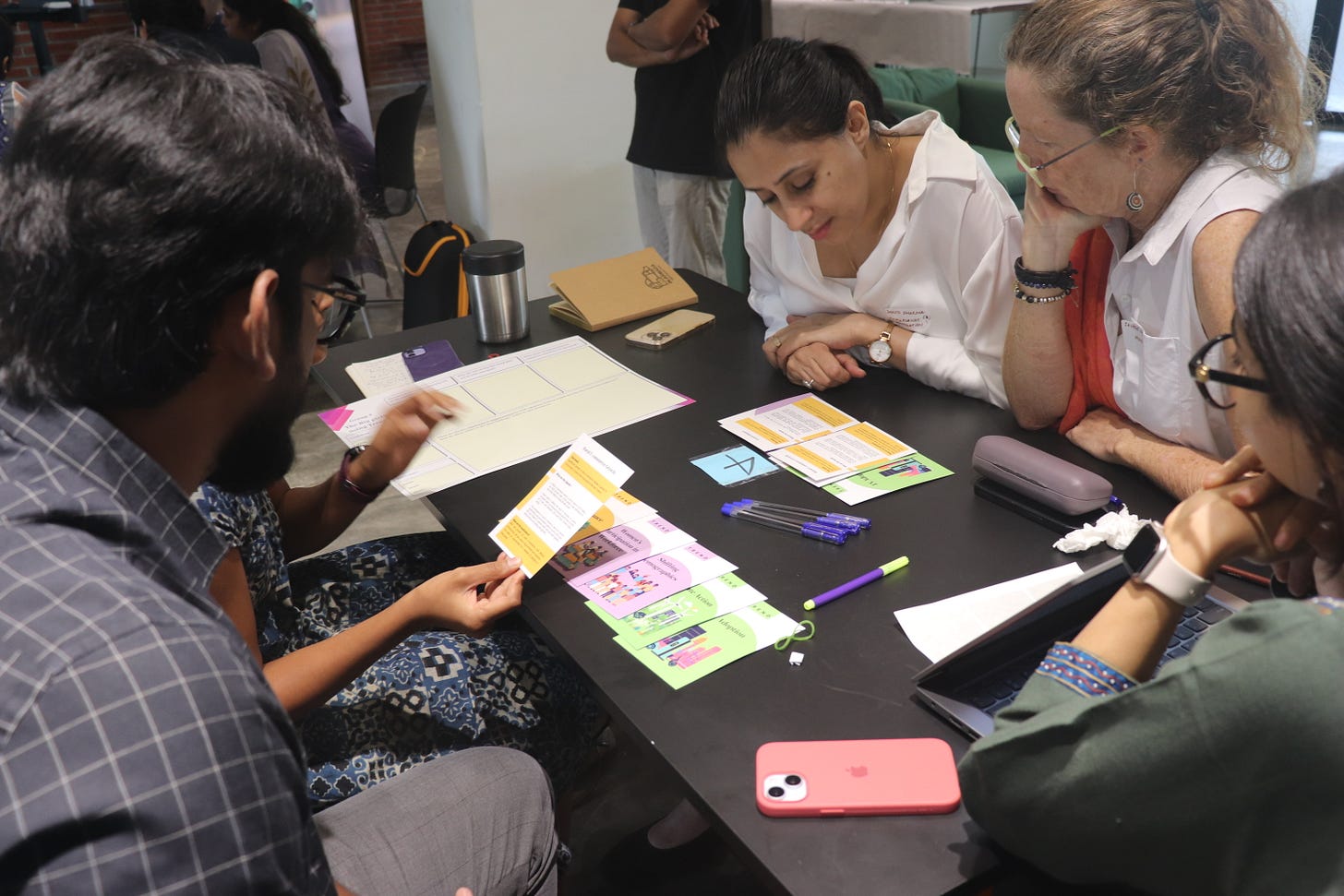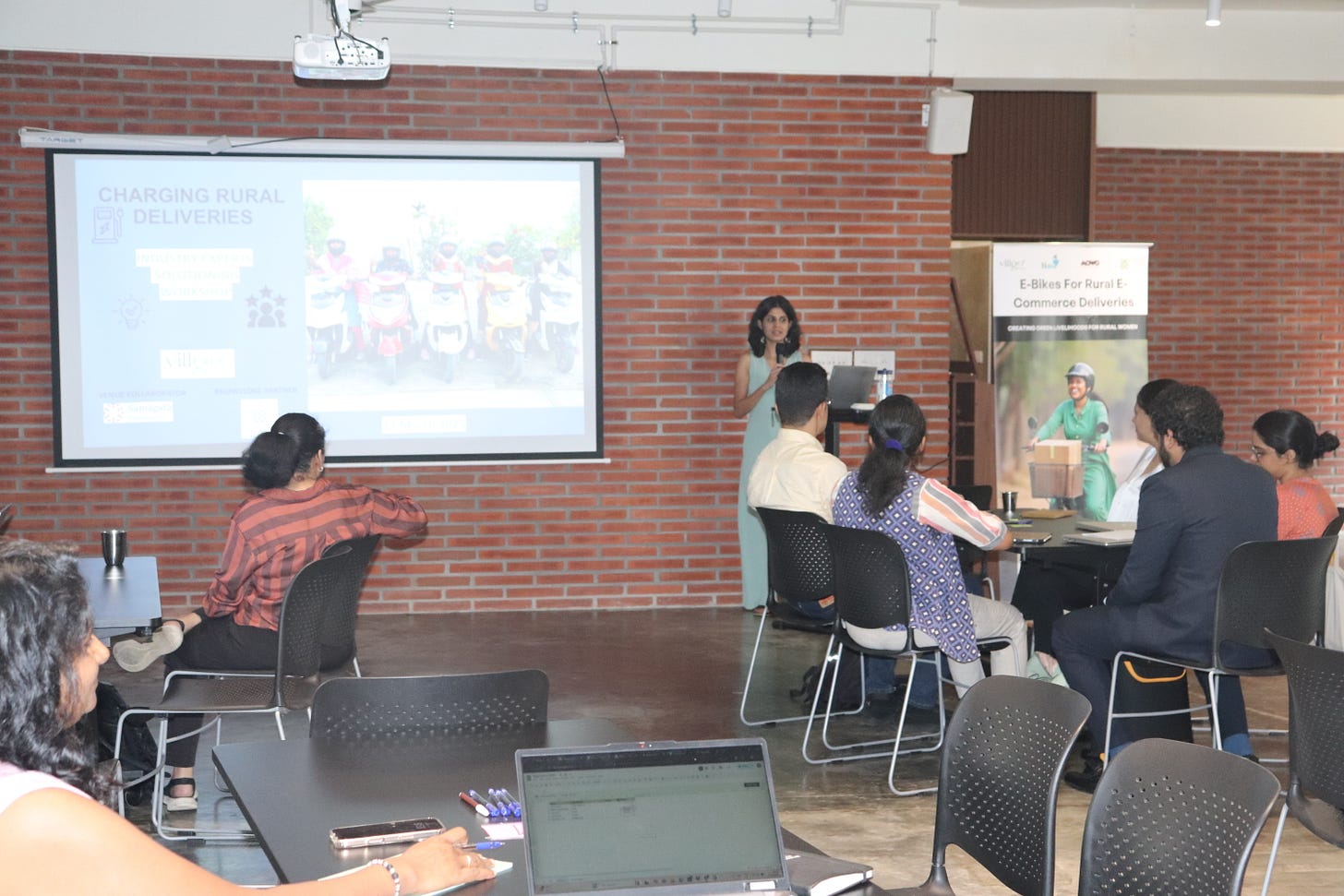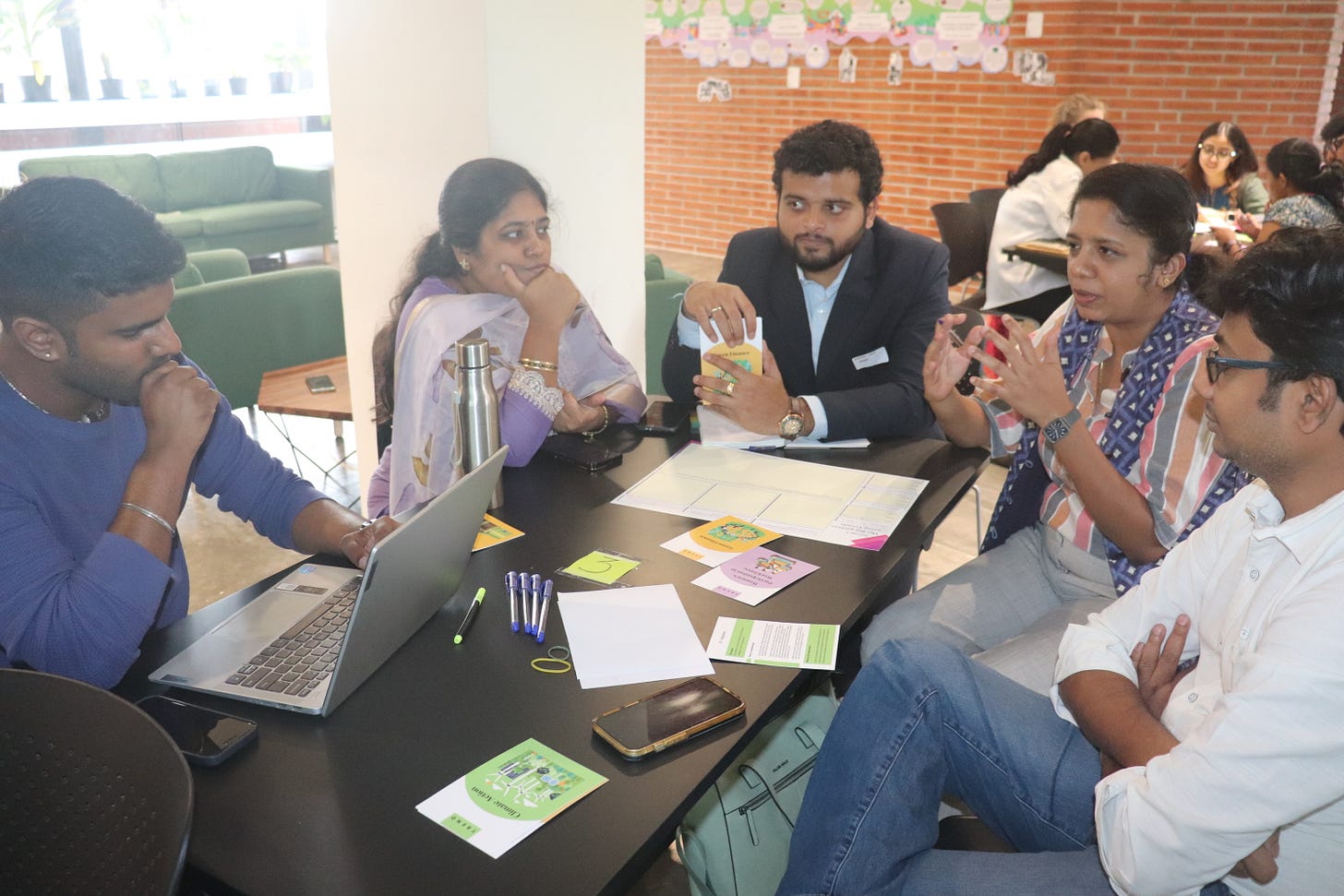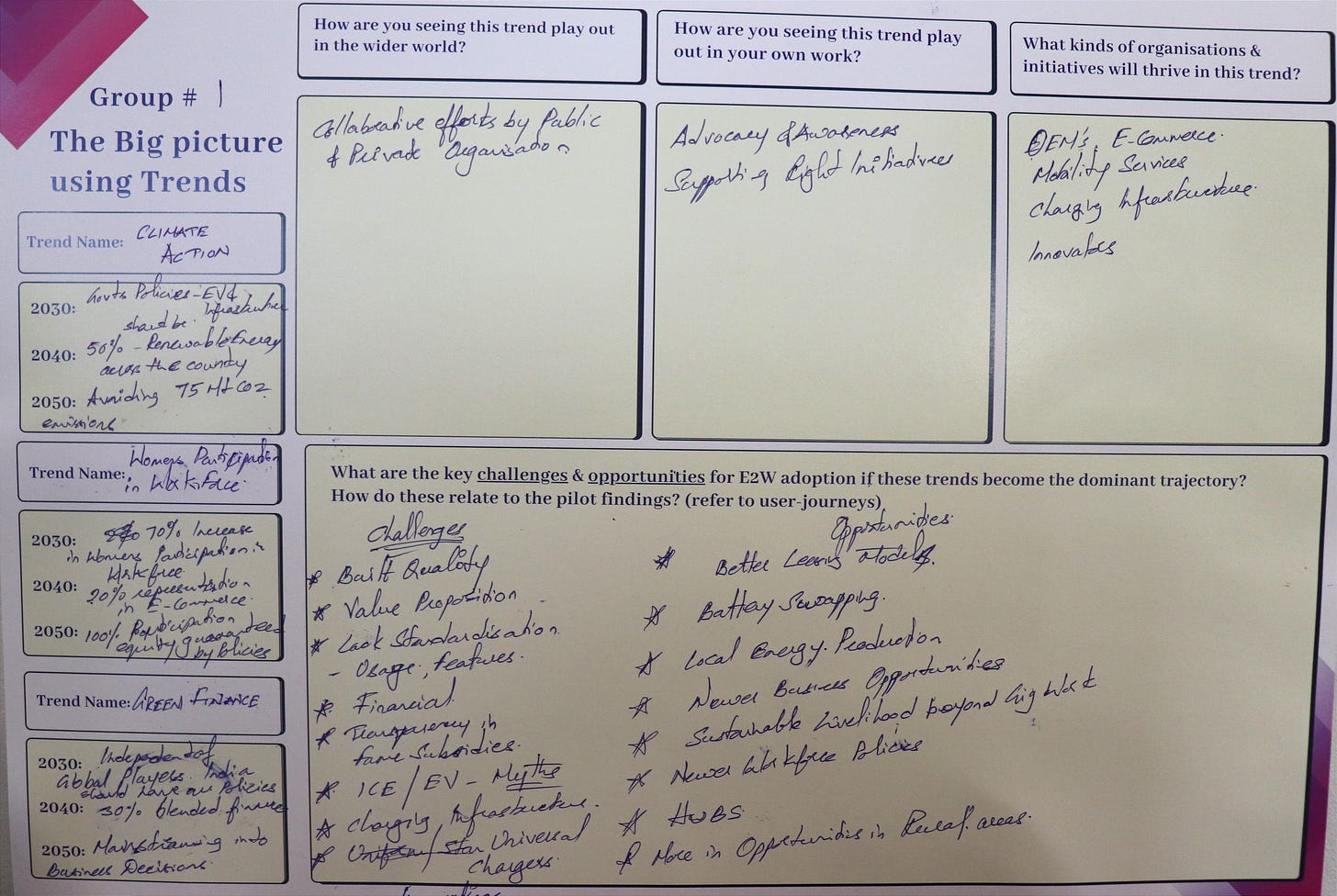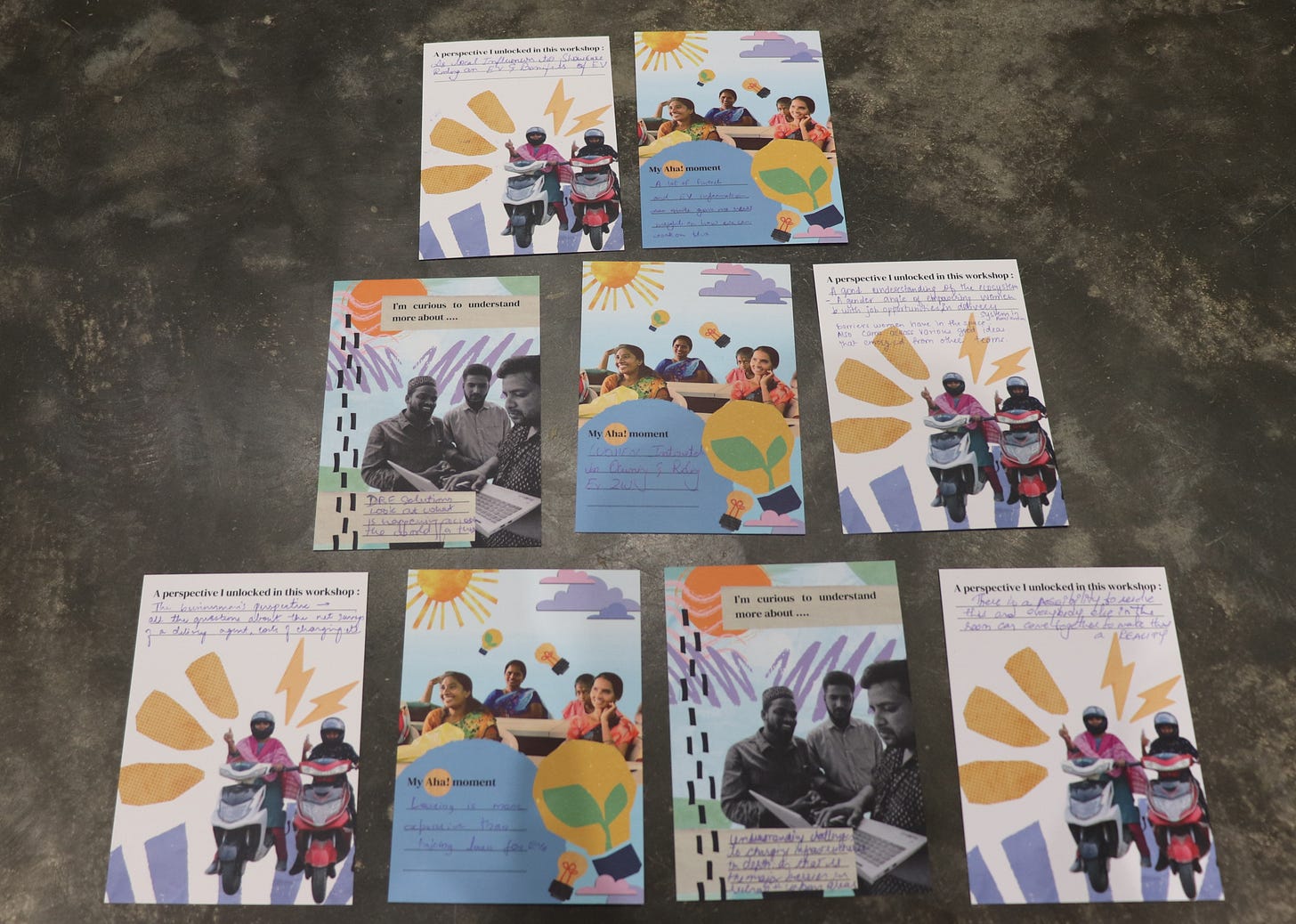The Socratus Way of Convening, Part 1: with Villgro on March 17th
Introduction
On March 17th, Villgro and Socratus co-designed a workshop at Samagata Space, Bangalore called "Charging Rural Deliveries”. The event brought together key players in the electric vehicle (EV) sector to discuss findings from a recent pilot study conducted by Villgro and its partners and brainstorm solutions for rural EV adoption. Participants included charging infrastructure companies, EV fleet operators, women-focused social enterprises, and financial institutions. The group focused on three main challenges:
Making e-bikes more affordable through better financing
Increasing participation of women and underserved groups
Developing charging infrastructure in rural areas
Socratus has long championed the idea that the most sustainable, community-centered answers come not from any single institution or individual, but from an evolving collective process - an 'ecosystems approach.' By partnering with Villgro, an incubator known for its work with social enterprises, the workshop leveraged each organization's strengths: Socratus's emphasis on collective wisdom and creative facilitation, and Villgro's deep experience in supporting early-stage social ventures.
Socratus's Approach to Partnerships and Convenings
Socratus believes that multi-stakeholder collaboration is essential when dealing with "wicked" problems—challenges that are complex, interdependent, and resistant to single-solution fixes. We believe that enhanced capacity for collective action and collaboration is the bedrock of lasting social change. Within our systems transformation practice, we focus on cultivating carefully designed and curated spaces. We use data and design capabilities to enhance system-level change practices towards the following outcomes:
Sensing the whole
Building empathy for all stakeholders
Reorienting existing power relations towards just and regenerative outcomes
Our methodology drives skillful action across different levels of the system by fostering wisdom attributes including Collective Action, Collective Imagination, Trust, Empathy, Wickedness, and Justice. Recognizing that many change-making approaches remain largely cognitive, we add an affective layer by bringing together the "facts" with the "felts." We incorporate elements of serious play—like live action role play, metaphors, and visioning exercises—to break existing molds and suspend limiting mindsets.
Moreover, Socratus sees convenings not as isolated gatherings but as part of a broader, iterative process. With Villgro, the workshop on the 17th was a launchpad for further innovation, building momentum that could translate into pilot projects, pitch events, or mentorship opportunities. This approach differs from a one-off conference or seminar format; it seeks to maintain continuity of relationships and ideas long after the day concludes.
Workshop Flow: Starting with Ground Truth
The day began with an introduction to the pilot study, conducted by Villgro, its research partners Alliance for Energy Efficient Economy implementation partners Hala mobility and MOWO Social Initiatives Foundationsin the Warangal and Sangareddy districts of Telangana, India.
Villgro shared a broad overview of the study design and findings, followed by partner organizations who discussed their learnings and challenges. Participants engaged with questions about the study, introduced themselves and their organizations, and shared one word that came to mind when thinking about "Charging Rural Deliveries."
As participants mingled over tea, they gathered around an exhibition wall showcasing the Sangareddy and Warangal pilot program. The wall displayed an intricate user journey, brought to life through authentic quotes from both male and female participants of the study. Through thoughtful iconographic labeling, the exhibition illuminated the human story behind the pilot, revealing not just what happened, but also how it felt for those involved.
The careful curation highlighted key touchpoints in the participants' experience:
Needs that drove participation
Actions taken by community members
Barriers they encountered
Crucial enablers that supported their success
The journey map wove together diverse voices and experiences, marking pivotal moments like when participants first considered vehicle ownership or discovered e-bikes. It tracked the evolution of women participants into e-commerce delivery agents and captured the new and evolving relationship with the e-vehicles for the men. Particularly poignant were the quotes from women in the pilot, who spoke of learning to drive and obtaining licenses - additional steps that highlighted both gender-specific challenges and the program's commitment to equity. Through this living document, visitors could trace the full arc of transformation, understanding both the practical and personal dimensions of this innovative pilot.
Futuring and Trend Cards
One of Socratus's key facilitation techniques is "futuring," which helps participants creatively imagine various scenarios five, ten, or even twenty years down the line. Many strategic planning efforts focus on immediate next steps—budget allocations, stakeholder engagement, or tactical improvements. Futuring, by contrast, invites a temporary suspension of present constraints, encouraging participants to dream more expansively and to consider how technological, social, and policy trends might converge or clash in the years to come.
To help participants take a step back and shift their perspective on electric two-wheelers (E2Ws), we introduced Trend Cards. These cards highlighted larger developments in the EV world that might influence both E2W production and the E2W delivery sector. We created Trend Cards covering six key themes:
Women in the Workforce
Shifting Demographics
Rural E-commerce Growth
Green Finance
Climate Action
EV Adoption
Each card showed real-world signals of the trend and its potential implications for electric two-wheelers. All four groups chose to explore 'Women's participation in the Workforce,' while at least two teams explored each of the other themes, except Shifting Demographics, which wasn't selected by any team.
During group discussions, participants explored how these trends might unfold over time (2030, 2040, 2050) in two ways:
1. How would the wider world change?
2. How their work would be impacted?
This exercise helped everyone step back and see the bigger picture around EV adoption. They could imagine both future challenges and opportunities, connecting these insights to what they had learned from the pilot study. We captured all the discussions using a simple template we designed.
Challenges and Opportunities for Rural EV Two-Wheeler Adoption
Building on their trend analysis, participants identified several key challenges and opportunities for expanding electric two-wheeler use in rural deliveries.
Key Challenges
Safety Concerns:
Charging infrastructure safety
Stability of heavily loaded vehicles
Infrastructure Gaps:
Inadequate and non-standardized charging stations
Limited profitability potential in rural areas
Scarcity of fast-charging options
Women-Specific Barriers:
Social and cultural norms view delivery work as "men's jobs"
Road safety fears
Limited digital literacy
Low awareness of opportunities in the mobility sector
Policy Implementation Challenges:
Lengthy application processes for government programs
Lack of end-user schemes
Outdated subsidy structures do not cover newer models
Gender bias in financing (male guarantors are often required for women)
Energy Infrastructure Needs:
Grid upgrades to handle increased EV demand
Distributed renewable energy (DRE) solutions for sustainable adoption
Key Opportunities
Safety Innovations:
Improved EV charging features to boost consumer confidence
Financial Access:
SHG members are increasingly obtaining loans without traditional credit scores
Innovative models: operating leases, risk-sharing arrangements, SHG-facilitated lending
Market Growth Potential:
Better fleet management and data-driven logistics
Larger delivery vehicles for expanding capacity
Emerging markets for used and rental EVs in smaller cities
Business opportunities in battery swapping technology and charging infrastructure
Green Finance:
New pathways for directing funds toward sustainable technologies
Blended finance models to help tap into CSR funds
Opportunities to attract retail investors to the E2W sector
From Insight to Action
The afternoon session brought fresh energy as groups dove into creative problem-solving. Building on their morning insights, teams brainstormed solutions and carefully selected their most promising ideas. They evaluated each concept through multiple lenses - looking at root causes, potential impact, practical feasibility, and alignment with the day's earlier discussions.
Using business canvas models as their guide, participants mapped out stakeholders, explored funding possibilities, and outlined specific requests for funders and policymakers.
The workshop's thoughtfully structured activities created space for both imaginative thinking and practical planning. Thanks to Villgro's careful selection of participants and group composition, the sessions produced concrete, actionable plans with potential to shape policy and drive innovation across regions.
Innovative Solutions for Rural EV Adoption
The workshop's four teams each crafted distinctive approaches to rural electric two-wheeler adoption, addressing complementary dimensions of this complex ecosystem challenge.
Group 1: E-SHGs (Electric Self-Help Groups)
This team reimagined traditional women's collectives as comprehensive EV hubs offering an integrated solution bundle: financing mechanisms, renewable-powered charging infrastructure, rest facilities, driver education, and vocational training. With inclusive pay-as-you-go pricing models and family-supportive amenities like childcare, these centers would systematically dismantle barriers facing rural women--from limited credit history to vehicle access challenges. The implementation framework identified critical cross-sector partnerships spanning renewable energy providers, financial institutions, training organizations, vehicle manufacturers, and government agencies, with a bold recommendation that such centers become standard infrastructure in every district.
Group 2: Decentralized Renewable Energy Networks
Targeting the rural charging infrastructure gap, this team proposed a distributed energy model that would transform local businesses, households, and small establishments into energy producers through strategic incentives. This grassroots approach simultaneously addressed twin challenges: charging station scarcity and increasing rural energy demands. Their implementation strategy prioritized three critical enablers: streamlining bureaucratic approval processes, democratizing access to technology and financing, and cultivating partnerships among local authorities, renewable energy manufacturers, and installation specialists. Beyond supporting EV adoption, this community-powered energy ecosystem promised broader rural infrastructure resilience.
Group 3: Panchayat-Led Demand Aggregation
This solution leveraged village panchayats as EV demand aggregators to overcome financial barriers for rural delivery workers. The model employed pooled purchasing power, risk-sharing mechanisms, and revolving funds to acquire vehicles for lease to delivery agents--converting prohibitive upfront costs into manageable recurring payments. The team designed a diversified funding architecture drawing from government programs, specialized financial institutions, non-bank lenders, and corporate social responsibility initiatives. With self-help groups and outreach partners driving beneficiary identification and awareness-building, the proposal recommended a measured approach: beginning with a focused two-village pilot before broader implementation.
Group 4: NSDC-Recognized Training Ecosystem
Focused on expanding e-commerce delivery opportunities for rural women, this team designed NSDC-recognized Training Centers that integrated certified skills programs with EV charging infrastructure and essential gender-responsive features like childcare and proper sanitation facilities. Their financial model included bi-weekly payment structures to enhance income stability for delivery partners. Success hinged on orchestrating collaboration between the National Skill Development Corporation, industry partners, local enterprises, and micro/small businesses, supported by blended funding from government initiatives, corporate responsibility programs, and private investment.
Reflection and Intention-Setting
As the workshop drew to a close, participants engaged in a deliberate moment of reflection through a postcard exercise--a simple yet powerful tool for integration and forward momentum. These cards created space for participants to articulate newly gained perspectives and identify knowledge areas they wished to explore further. More importantly, the exercise invited each person to set a concrete intention for translating the day's insights into action beyond the workshop setting. This thoughtful conclusion honored both the collaborative wisdom generated throughout the day and the individual agency required to manifest change in participants' respective spheres of influence.
Conclusion
In a world increasingly defined by rapid change and interconnected challenges, imagination stands alongside capital and infrastructure as a critical resource for transformation. The Socratus-Villgro partnership in Bangalore demonstrated how methodically designed convenings can cultivate this collective imagination--converting abstract possibilities into actionable pathways and collaborative frameworks. The effectiveness of such gatherings hinges on creating environments that skillfully balance visionary thinking with pragmatic implementation, encouraging participants to transcend immediate constraints while remaining grounded in present realities.
When executed with intention, participants emerge not merely inspired but strategically equipped. They develop capabilities to refine nascent concepts, evaluate feasibility, secure resources, and identify essential allies within their broader ecosystem. Perhaps most significantly, they cultivate deeper relational networks, recognizing that sustainable change emerges not from isolated interventions but through communities of practice united by a shared commitment to collective flourishing. This understanding--that systems change requires both innovative solutions and the social fabric to sustain them--represents the enduring legacy of the Socratus approach to convening. If you’re eager for a more in-depth coverage of this event, please visit think link.






